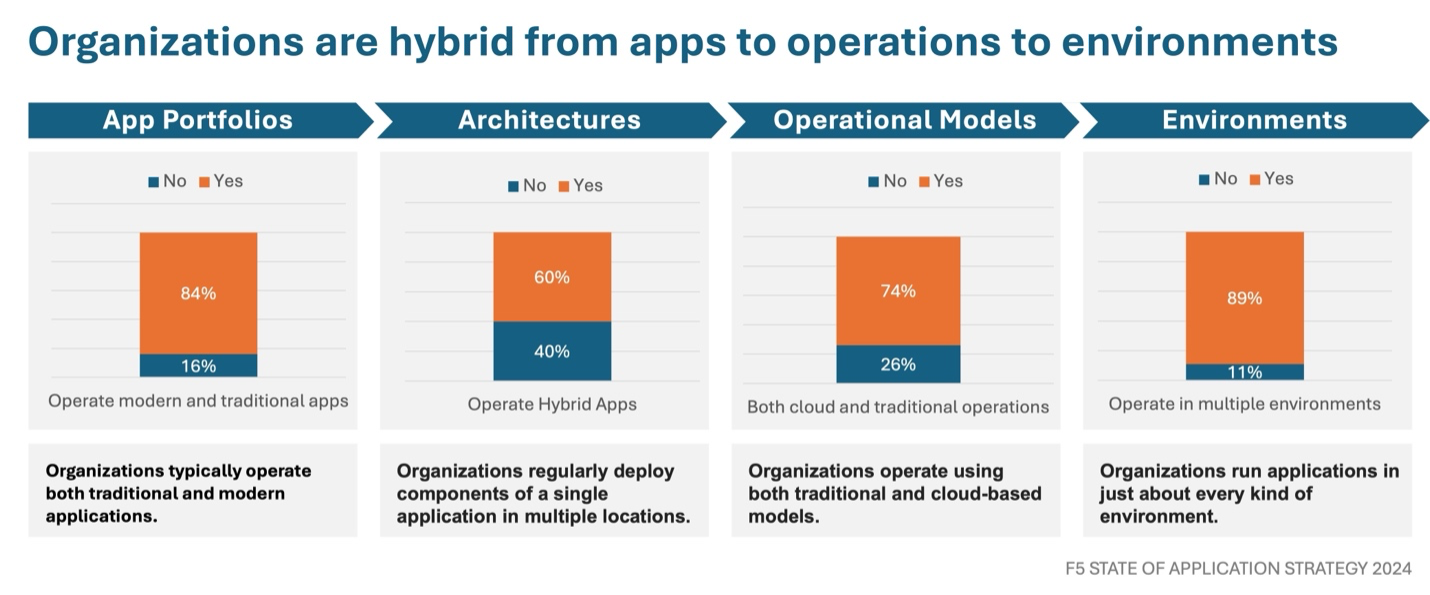2024년 응용 전략 상태: 하이브리드 IT 트렌드 탐색
마케팅 과장이 무엇을 의미하는지라면, 업계에서는 기업이 대부분 하이브리드라는 사실을 받아들인 것입니다.
하이브리드는 클라우드와 엣지, 심지어 AI 와 마찬가지로 의미심장한 용어입니다. 하지만 일반적으로 우리는 하이브리드를 "두 가지 다른 무언가로 구성된 무언가"를 의미하는 데 사용합니다. 원하신다면, '하이브리드' 대신 '이질적인'을 대체해서 사용해도 거의 같은 의미가 됩니다.
예를 들어, 하이브리드 애플리케이션 포트폴리오란 조직에서 관리하는 애플리케이션 세트에 최신 애플리케이션(모바일, 마이크로서비스)과 기존 애플리케이션(클라이언트-서버, 모놀리스, 3계층 웹)이 모두 포함된다는 것을 의미합니다.
우리는 이와 동일한 용어를 기업의 다른 측면, 예를 들어 아키텍처, 운영, 심지어 조직이 애플리케이션을 배포하고 운영하기로 선택한 환경에도 적용합니다.
하이브리드 사물을 인식하는 것이 왜 중요한가요? 하이브리드는 무엇이든 단일 "사물"을 개발, 배포, 운영 또는 보호할 때는 나타나지 않는 특별한 과제를 안겨줍니다. 무엇이든 이질적인 것이 있으면 팀, 도구, 관행, 프로세스도 달라진다.
그리고 아이들아, 복잡성은 바로 거기서 생겨나는 거야.
이는 오늘날 전형적인 기업의 상황입니다. 하이브리드의 복잡성에 압도당하면서도 가까운 미래에 하이브리드가 당연한 일이라는 것을 인식합니다.
이러한 관점에서 전형적인 기업을 살펴보면, 어떤 측면을 보더라도 조직은 절대적으로, 확고하게, 그리고 확실히 하이브리드적이라는 것을 알 수 있습니다.

앱 포트폴리오 에서 아키텍처, 운영 모델에서 환경에 이르기까지 모든 기업은 적어도 한 가지 종류의 이기종성, 그리고 보통은 그 이상의 이기종성으로 인한 과제에 직면해 있습니다.
하이브리드는 전략부터 실행까지 기업의 모든 것에 영향을 미칩니다. 이는 본질적으로 이기종 인프라, 애플리케이션 및 운영에서 발생하는 복잡성을 해결하는 기술과 동향에 대한 관심을 불러일으킵니다.
여러 클라우드에서 실행되는 단일 애플리케이션의 여러 구성 요소가 있다고 답한 응답자는 GraphQL , 마이크로서비스 네트워킹 , 대규모 언어 모델(LLM)과 같은 기술에 대해 더 큰 관심을 가질 가능성이 높습니다. 또한 그들은 멀티클라우드 네트워킹 , IT 중앙 집중화 , 슈퍼클라우드 에 대해 더 많은 관심을 보였습니다. 이는 모두 현대적 분산형 기업의 연결, 보안 및 관리에 따른 복잡성을 해결하는 데 초점을 맞춘 트렌드입니다.
도구와 API 의 복잡성은 보편적인 과제이며, 올해 응답자의 94%가 멀티클라우드에서 가장 답답한 과제로 복잡성을 꼽았습니다. 하지만 이질성으로 인한 복잡성은 다른 곳에서도 나타나는데, 응답자의 절반 이상(52%)이 앱 제공 및 보안 자동화에 대한 장벽으로 툴링의 복잡성을 꼽았습니다. 네트워크 보안부터 CDN, VDI, SSL VPN까지 30개의 서로 다른 애플리케이션 서비스의 배포를 추적한다고 가정해 보겠습니다. 각각의 평균 배포율은 93%입니다. 즉, 모든 응답자의 93%가 30개의 앱 서비스를 모두 구축했다는 의미입니다.
모두가 상호 운용되는 것은 아닙니다. 사실, 많은 조직이 완전히 다른 도메인에 속하며 운영 및 관리에 대한 접근 방식도 다릅니다. 이것이 하이브리드의 현실입니다. 그것은 항상 반짝이는 애플리케이션 외관 아래에 존재하며 디지털 변환을 통해 노출될 때를 기다리고 있습니다.
모든 서비스를 운영, 제공 및 보호하는 데 필요한 하나의 퍼블릭 클라우드에 "올인"하지 않는 한 하이브리드에서 벗어날 수 없습니다. 우리는 그것이 추세로 자리잡을 것이라고 보지 않습니다. 조직의 2%만이 "전부 참여"하고 있으며, 그 중에서도 단 34%만이 단일 클라우드 공급업체에 의지하고 있습니다. 올인원 퍼블릭 클라우드에 포함된 것은 이상치입니다.
조직은 분산되어 있으며, 멀티클라우드 , 하이브리드 환경을 갖추고 있습니다.
즉, 기존 솔루션도 모든 앱과 API를 어디서나 제공하고, 보호하고, 최적화할 수 있는 분산형 멀티클라우드 하이브리드 서비스로 전환되어야 합니다.
하이브리드 IT와 그에 따른 과제, 그리고 조직들이 어떻게 대응하고 있는지에 대한 자세한 내용은 2024년 애플리케이션 전략 현황 보고서 에서 확인할 수 있습니다.
